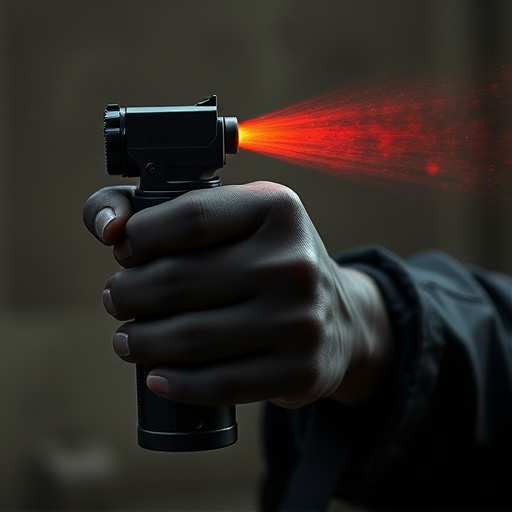Pepper spray, a powerful defense tool, uses capsaicin to irritate attackers but requires immediate action after exposure. To remove pepper spray residue from clothing, wash with soap and warm water within hours. Turn garments inside out, rinse affected areas, and launder with hot water and detergent. Avoid bleach or fabric softeners until the irritant is fully dissolved. Regulated by law, its use demands reasonable and proportional response to threats. Promptly removing pepper spray from clothes prevents cross-contamination and preserves evidence. After exposure, gently wash skin and flush eyes with water for 15 minutes. Seek medical attention, report incidents, and update personal safety plans.
“Maximize your personal safety with a comprehensive guide to pepper spray defense. Understanding how pepper spray works and its potent effects is crucial. Learn effective strategies to remove pepper spray residue from clothing, a critical step after exposure. Explore legal aspects of self-defense and the use of pepper spray, ensuring you stay within the boundaries of the law. Discover prevention tips to safeguard against future incidents, empowering you with knowledge for enhanced personal security.”
- Understanding Pepper Spray and Its Effects
- Steps to Remove Pepper Spray from Clothing
- Legal Considerations: Self-Defense and Pepper Spray
- Prevention and Safety Tips for Future Incidents
Understanding Pepper Spray and Its Effects
Pepper spray, a powerful defense tool, is designed to incapacitate an attacker temporarily by irritating the eyes and respiratory system. Comprised of capsaicin, the same compound that makes chili peppers spicy, it creates a burning sensation and can disrupt vision for several minutes. When deployed, pepper spray adheres to clothing, skin, and hair, making removal crucial for safety and legal reasons after use.
Understanding how pepper spray works is key to effective defense. It’s essential to know the proper techniques for removing the residue from clothing to prevent potential health risks and ensure admissibility of evidence if needed. Prompt action is required; washing affected areas with soap and warm water within a few hours can significantly reduce the spray’s potency and minimize its impact on the body.
Steps to Remove Pepper Spray from Clothing
If you find yourself facing a pepper spray attack, one of the crucial steps for self-defense is knowing how to quickly and safely remove the spray from your clothing. Start by removing any contaminated garments immediately; do not try to wash them off directly as this can spread the irritant further. Take off each piece of clothing slowly, turning it inside out to prevent direct contact with the skin and other items.
Rinse the affected areas with plenty of water, ensuring that all traces of pepper spray are washed away. You can also use a mild soap solution for sensitive skin. After rinsing, carefully launder your clothes using hot water and a good detergent. This will help to dissolve and remove any residual pepper spray oil. Avoid using bleach or fabric softeners until the clothing is completely free from the irritant to prevent further discomfort.
Legal Considerations: Self-Defense and Pepper Spray
When considering a pepper spray defense for self-defense, it’s crucial to understand the legal implications and restrictions in your jurisdiction. In many places, carrying and using pepper spray is regulated, with specific laws governing its use as a defense tool. Self-defense laws vary widely, but generally, you must act reasonably and proportionately to the perceived threat. Using pepper spray may be considered a valid self-defense mechanism if you believe your safety is at risk and there’s no reasonable alternative.
However, it’s essential to be aware that improper use or carrying pepper spray can lead to legal consequences, including charges of assault or unlawful possession. After an incident, it’s vital to ensure the safe removal of pepper spray from clothing to prevent cross-contamination and potential false accusations. This step is critical in maintaining your defense and preserving evidence for any legal proceedings that may arise.
Prevention and Safety Tips for Future Incidents
After a pepper spray incident, prevention and swift action are key to minimizing future risks. If exposed, the first step is to remove any pepper spray from clothing as quickly as possible. Rubbing or scratching affected areas should be avoided; instead, gently wash the skin with soap and water, ensuring thorough rinsing. For eyes, flush them with clean water for at least 15 minutes, keeping lids open.
Seeking medical attention is advisable, even if symptoms seem mild, as pepper spray can cause respiratory distress or other health issues. In public places, ensure you report the incident to authorities and inform management or security. Regularly updating personal safety plans and attending self-defense courses can empower individuals to better handle similar situations in the future.
Pepper spray can be a powerful tool for self-defense, but it’s crucial to understand its effects and legal implications. Knowing how to effectively remove pepper spray from clothing is essential for safety and prevention. By following the steps outlined in this article, you can mitigate the impact of accidental exposure. Remember that, while pepper spray has its uses, responsible ownership and proper handling are key. Always stay informed about local laws regarding self-defense and keep yourself prepared with knowledge and resources to ensure your safety and the effectiveness of your defenses.
